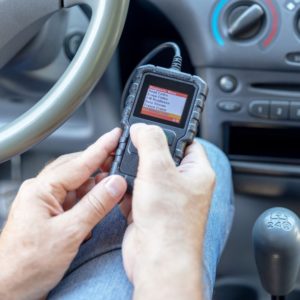The evaporative emissions control (EVAP) system is designed to prevent fuel vapors from escaping into the atmosphere. To find leaks, some EVAP systems have a leak detection pump. The pump generates a vacuum in the system, which will quickly reveal the presence of a leak.
The powertrain control module (PCM) runs the leak detection pump after the vehicle has stayed still for several hours. If the pump doesn’t activate or a vacuum doesn’t form in the EVAP system, the control module will log a P2419 code.
What Does the P2419 Code Mean?
The diagnostic trouble code (DTC) P2419 indicates “Evaporative Emission System Switching Valve Control Circuit Low.” It applies to vehicles that use a leak detection pump instead of a pressure sensor.

The EVAP system keeps gasoline vapors from leaving the fuel system and entering the atmosphere as emissions. While it is a generally reliable system, the emission control system can develop problems that can trigger the check engine light and spell automatic failure during an OBD-II plug-in emissions test.
In vehicles built from 1996 onward, the OBD-II EVAP monitor diagnoses the emission control system for any indications of a fuel vapor leak. When it detects a leak, the monitor will log the appropriate fault code in the PCM.
To run the diagnostic check, the EVAP monitor needs certain conditions to be correct. Once these parameters are met, the monitor activates the leak detection pump.
The leak detection pump pulls the EVAP system into a vacuum condition. It keeps track of the air pressure throughout the system and tests if the various parts can maintain the airtight seals.
If the PCM notices that the leak detection pump isn’t working or producing a vacuum, it will set the generic engine code P2419.

Note: The definition of code P2419 can differ according to the vehicle manufacturer. Check the appropriate repair manual or repair database for the exact code definition.
What are the Common Causes of the P2419 Code?
- Bad canister pump module
- EVAP hose leaks or is pinched
- Faulty PCM
- Wiring problems, such as shorted and open wires
What are the Common Symptoms of the P2419 Code?
How to Diagnose the P2419 Code
The P2419 code is a generic engine code that various makes and models can log. However, this does not mean that there is a one-size-fits-all solution to identify its underlying problem.
If you’re not confident about conducting diagnostic tests on your vehicle, it’s a good idea to bring it to a professional mechanic. Otherwise, you can go ahead and diagnose the issue yourself.
How to Fix the P2419 Code
Attempting to fix a P2419 code can become challenging if you don’t have the right tools and know-how to test the leak detection pump. In most cases, it’s best to leave the job to professionals.
For DIYers with advanced technical knowledge and hands-on experience who prefer to test and replace their vehicle’s leak detection pump on their own, it will be helpful to rely on the appropriate repair manual or refer to an online repair database.
Any information provided on this Website is for informational purposes only and is not intended to replace consultation with a professional mechanic. The accuracy and timeliness of the information may change from the time of publication.


















